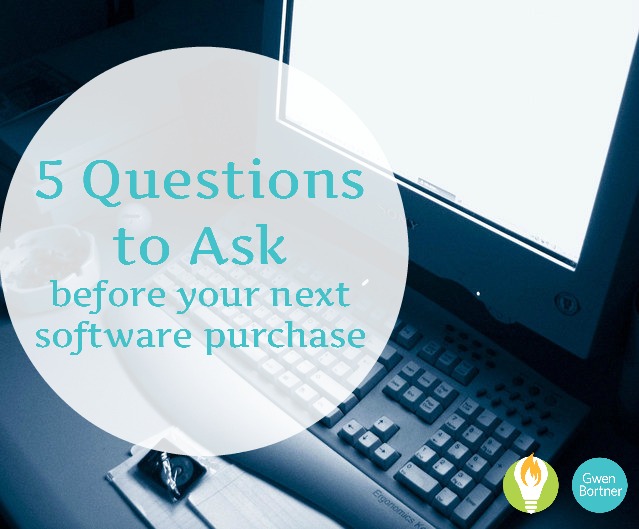One of the biggest challenges in managing your business on an ongoing basis is deciding when it is time to make a change, particularly when it comes to selecting the software and apps we use every day.
It is so easy to get comfortable with something we use every day that we will often overlook the challenges or work-arounds that we have in place to truly make it functional. Also, researching alternative products takes time that may not produce any useful results. Or, when you find a new option, then you need to take the time to make the migration, learn the new tool and implement new processes based on new capabilities. Much of the past week I have been doing all of the above. As such, I have been thinking about the criteria that I use when evaluating new software options. Ultimately the final criteria used for each evaluation will be slightly different, but even so, there are 5 questions you should ask before making a change in software.
1. What are the key pieces of functionality I require?
Start by considering what you really want to get accomplished. Many times the features we actually utilize are a significantly smaller part of what can be done. At the same time, think about areas that you might have developed a work-around. Is it possible that what you are trying to accomplish might be a built-in function in another solution?
As you list features and functions, classify each as critical, important or just a “nice to have” option. Keep in mind how much time will be saved or wasted if a function is or is not available. A solution that only fills a small portion of your critical needs but has lots of the nice-to-haves is probably not your best answer.
2. How does the price compare to my actual use?
Comparing prices can get difficult as there are a variety of pricing models that we regularly find in the software/application market. Is the purchase a one-time cost or is it a renewing subscription model? Does the price remain consistent or does it work on a sliding scale basis? Does that work in your favor in the short term, the long term, neither or both? Is the product designed for a business your size?
Although you cannot always accurately predict the future in terms of growth or needs, a software purchase that fills your needs for 3 years is considered acceptable. So consider where you think your business will be in 3 years when looking at longer term pricing implications.
3. How difficult will it be to migrate, implement and utilize on a regular basis?
This question is never an easy one to answer since real insights only come with actual hands-on experience. However, by taking advantage of reviews, case studies and endorsements you can often get a feel for the answer to this question. Combine that with your own understanding of yourself and the resources you have available and you will probably have a good idea.
Keep in mind that the more flexibility or options that a software or application has, the higher the probability it will take longer to master. If that flexibility makes it a really good fit, then the additional investment will undoubtedly pay off. However, if you are only utilizing a few key features, it may add unwanted time to the process.
Also consider what outside support is available if needed. In some cases, for one-time processes like migrating data, it makes more sense to just pay to have the process done than to try and figure it out on your own.
4. How well does it integrate with the other applications that I already use?
As the internet continues to make the world more connected, software applications from unrelated companies are becoming more and more integrated. In some cases, a new application is offered that combines the features that previously were only available from several distinct sources. Other times, formal arrangements are made between companies to work together and share data relatively seamlessly. This is always a preferred solution if it meets the other criteria.
However, if you are already committed to a critical piece of software, sometimes a bit of a manual work-around might actually be preferable. That being said, most of the time it is possible to find a solution that will integrate. If not, ask if it is a possible future development. Requests from users are where the majority of improvement ideas begin.
5. Does the company backing the software seem “solid”?
This is another question that can be difficult to answer when it is not immediately obvious. If the product is from a major player that is universally familiar, this rarely has to come into consideration. However, lots of great products are created by companies (and individuals) that may never become a big player.
The actual question to ask yourself is how big a deal would it be if the company no longer existed. If it is something that requires regular updates or stores your data this might be a big problem. Is it mission critical to your business? Could it be replaced relatively easily with another piece of software or application?
Going with the “old standards” is usually a safe bet, but not always the best choice. Then again, taking a risk on a new company might be just be too risky. Each situation is different, so each time the answer might change.
If you answer all these questions “correctly,” will that ensure a perfect match? There is never a guarantee, but huge disappointments will be far fewer. Regardless, keep in mind that dithering over making a decision can often be the biggest mistake of all. Ultimately you need to make a choice and learn (both good and bad) from the process.


